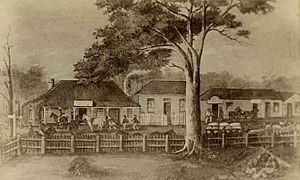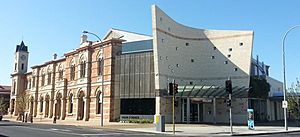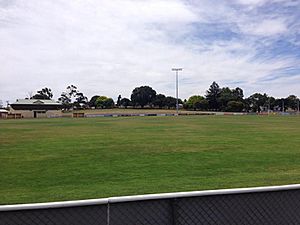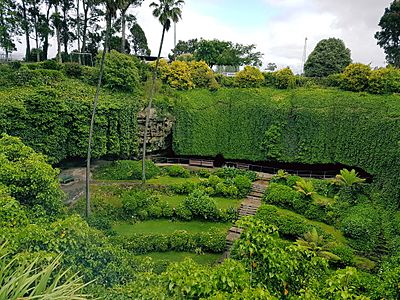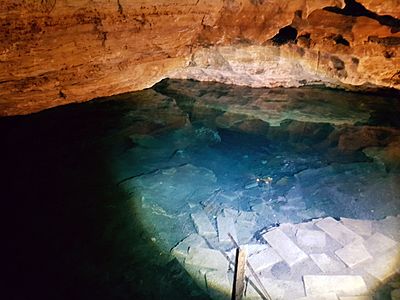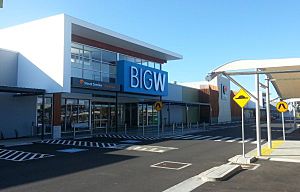Mount Gambier, South Australia facts for kids
Quick facts for kids Mount GambierSouth Australia |
|||||||||||||||
|---|---|---|---|---|---|---|---|---|---|---|---|---|---|---|---|
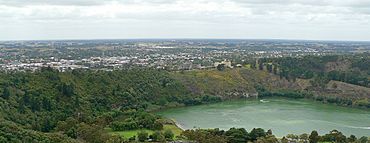
View north across Valley Lake and Marist Park to the eastern urban area of Mount Gambier from Centenary Tower
|
|||||||||||||||
| Population | 29,639 (2018) (47th) | ||||||||||||||
| • Density | 153.33/km2 (397.1/sq mi) | ||||||||||||||
| Established | 1854 | ||||||||||||||
| Postcode(s) | 5290, 5291 | ||||||||||||||
| Area | 193.3 km2 (74.6 sq mi)(2011 urban) | ||||||||||||||
| Time zone | ACST (UTC+9:30) | ||||||||||||||
| • Summer (DST) | ACDT (UTC+10:30) | ||||||||||||||
| Location | |||||||||||||||
| LGA(s) |
|
||||||||||||||
| County | Grey | ||||||||||||||
| State electorate(s) | Mount Gambier | ||||||||||||||
| Federal Division(s) | Barker | ||||||||||||||
|
|||||||||||||||
|
|||||||||||||||
Mount Gambier is the second most populated city in South Australia with an estimated urban population of 29,639. The city is located on the slopes of Mount Gambier, a volcano in the south east of the state, about 450 kilometres (280 mi) south-east of the capital Adelaide and just 17 kilometres (11 mi) from the Victorian border. The traditional owners of the area are the Bungandidj people.
Mount Gambier is the most important settlement in the Limestone Coast region and the seat of government for both the City of Mount Gambier and the District Council of Grant.
The city is well known for its geographical features, particularly its volcanic and limestone features, most notably its Blue Lake, parks, gardens, caves and sinkholes.
Contents
History
Before European settlement, the Buandig (or Boandik) people were the original Aboriginal inhabitants of the area. They called it 'ereng balam' or 'egree belum', meaning 'home of the eagle hawk'.
The peak of the dormant Mount Gambier crater was sighted in 1800 by Lieutenant James Grant from the survey brig, HMS Lady Nelson, and named for Lord James Gambier, Admiral of the Fleet.
The Henty brothers who owned large holdings in Portland, Western Victoria, laid claim to the land but were forced to retreat when the lands were granted to Evelyn Sturt, the brother of the explorer Charles Sturt. Industries soon began to appear. The Post Office opened on 22 September 1846, John Byng built the Mount Gambier Hotel in 1847, and Dr Edward Wehl arrived in 1849 to begin a flour-milling operation.
Hastings Cunningham founded "Gambierton" in 1854 by subdividing a block of 77 acres (31 ha). From 1861 to 1878 the Post Office was known by this name before reverting to Mount Gambier. Local government appeared in 1863 when Dr Wehl, who now owned a substantial millhouse on Commercial Road, was elected chairman of the District Council of Mount Gambier. In December 1864 this became the District Council of Mount Gambier West and, at the same time, a separate District Council of Mount Gambier East was formed.
Incorporation in 1876 saw a further division, with the creation of the Town Council and Mr John Watson elected Mayor. Mount Gambier was governed in this fashion until 1932, when the District Council of East and West merged to form a single District Council of Mount Gambier once more.
On 9 December 1954, Mount Gambier was officially declared a city, and is now an important tourism centre in south-east South Australia.
Geography
Mount Gambier's urban area is located mainly along the northern slopes and plain of a maar volcano of the same name, Mount Gambier. Comprising several craters, it is part of the Newer Volcanics Province complex of volcanoes. One of these contains a huge lake of high-quality artesian drinking water which changes colour with the seasons. In winter, it is a steel grey and then changes to a spectacular cobalt blue in the summer, giving rise to its name, Blue Lake. This 70-metre (230 ft) deep lake also accommodates a range of unusual aquatic flora and fauna, in particular fields of large stromatolites. There are several other craters in the city including Valley Lake and the Leg of Mutton Lake. The region surrounding the city also includes other volcanic features such as Mount Schank, along with many karst features such as water-filled caves and sinkholes.
The urban area extends outside of the City of Mount Gambier into the District Council of Grant where the following suburbs now exist: Suttontown, Mil Lel and Worrolong to the north of the city, Glenburnie to the east, Compton to the west, and Moorak and OB Flat to the south.
Climate
Mount Gambier has a warm-summer Mediterranean climate (Koppen: Csb). The town has warm dry summers and cool wet winters. July is the wettest month with an average of 99.6 mm falling on 22 days whilst February normally records the lowest rainfall with an average of 25 mm on an average 8 days. The highest ever temperature recorded in Mount Gambier was 44.9 °C on 2 February 2014 and the lowest ever temperature recorded was −3.9 °C on 20 June 1950 and 2 July 1960. Mount Gambier has only 40.5 clear days on an annual basis.
| Climate data for Mount Gambier | |||||||||||||
|---|---|---|---|---|---|---|---|---|---|---|---|---|---|
| Month | Jan | Feb | Mar | Apr | May | Jun | Jul | Aug | Sep | Oct | Nov | Dec | Year |
| Record high °C (°F) | 44.1 (111.4) |
44.9 (112.8) |
41.3 (106.3) |
35.8 (96.4) |
28.5 (83.3) |
21.6 (70.9) |
22.4 (72.3) |
26.6 (79.9) |
32.2 (90.0) |
33.3 (91.9) |
41.2 (106.2) |
43.3 (109.9) |
44.9 (112.8) |
| Average high °C (°F) | 25.3 (77.5) |
25.3 (77.5) |
23.1 (73.6) |
19.5 (67.1) |
16.1 (61.0) |
13.9 (57.0) |
13.2 (55.8) |
14.1 (57.4) |
15.9 (60.6) |
17.9 (64.2) |
20.5 (68.9) |
22.9 (73.2) |
19.0 (66.2) |
| Average low °C (°F) | 11.2 (52.2) |
11.7 (53.1) |
10.5 (50.9) |
8.7 (47.7) |
7.3 (45.1) |
5.8 (42.4) |
5.2 (41.4) |
5.5 (41.9) |
6.3 (43.3) |
7.1 (44.8) |
8.4 (47.1) |
10.0 (50.0) |
8.1 (46.6) |
| Record low °C (°F) | 1.4 (34.5) |
2.8 (37.0) |
0.0 (32.0) |
−1.8 (28.8) |
−2.8 (27.0) |
−3.9 (25.0) |
−3.9 (25.0) |
−2.6 (27.3) |
−3.4 (25.9) |
−1.6 (29.1) |
−0.8 (30.6) |
1.2 (34.2) |
−3.9 (25.0) |
| Average precipitation mm (inches) | 27.2 (1.07) |
25.6 (1.01) |
35.3 (1.39) |
54.9 (2.16) |
70.8 (2.79) |
84.4 (3.32) |
99.6 (3.92) |
95.8 (3.77) |
71.9 (2.83) |
61.3 (2.41) |
46.5 (1.83) |
38.4 (1.51) |
710.2 (27.96) |
| Average precipitation days | 8.4 | 7.7 | 11.0 | 14.4 | 18.2 | 19.7 | 21.7 | 21.5 | 19.2 | 16.9 | 13.3 | 11.7 | 183.7 |
| Mean monthly sunshine hours | 282.1 | 243.6 | 213.9 | 165.0 | 136.4 | 120.0 | 133.3 | 164.3 | 171.0 | 213.9 | 228.0 | 251.1 | 2,322.6 |
Demographics
The government in the south-east area of the state, consisting of three local councils, amounted to a single administration. In consequence, many residents of Victoria used to look across the border to Mount Gambier as their centre. Consequently, during the 1970s many elderly locals relocated to Victor Harbor and Moonta, both rural areas but with more resources available to cope with an ageing population. A 1976 study found that less than 10 per cent (around 160 people) of residents aged over 65 had lived in the area for less than 5 years, leading to a lack of specific aged-care facilities.
According to the 2006 Census the population of the Mount Gambier census area was 24,905 people, making it the largest urban area in the state outside Adelaide, and the 50th largest urban area in Australia. Approximately 51.7% of the population were female, 84.9% were Australian born, over 91.5% of residents were Australian citizens and 1.6% were indigenous.
The most popular industries for employment were Log Sawmilling and Timber Dressing (8%), School Education (4.8%) and Retail Trade (3.8%), while the unemployment rate is approx. 7%. The median weekly household income is A$814 or more per week, compared with $924 in Adelaide.
According to the 2006 Census, 60.0% of residents identified themselves as being Christian. The largest denominations represented were Catholics at 21.5%, Anglicans at 11.4%, the Uniting Church at 8.6%, and Presbyterians at 6.9%. 26.9% of people claim no religion. A further 12.1% of people chose either not to state their beliefs, or did not adequately define them.
Arts and culture
The city's Civic Centre, around Cave Gardens, is the hub of the city's arts and includes the Riddoch Art Gallery, South Australia's major regional art gallery located in the adaptively reused old town hall complex. The complex was extended in 2011 to include "The Corner", a modern building which includes a theatre. Nearby are the public library and the old post office.
Music
Every year the town and the surrounding area, hosts nearly 3,000 young people for the Generations in Jazz Festival. Jazz artists like James Morrison, Daryl Somers, Ross Irwin, James Muller and Graeme Lyall travel to perform and adjudicate the stage band competition. Special guests have included Gordon Goodwin and his Big Phat Band
Sport
There are four Australian rules football teams competing in the Western Border Football League: North Gambier, East Gambier, South Gambier and West Gambier. They have produced such AFL players as David Marshall, Nick Daffy
There is also a range of different sporting leagues and clubs in Mount Gambier and surrounding regions, including soccer, netball, basketball, tennis, hockey, cricket, swimming, cycling, triathlon, rifle, gun and pistol shooting, lawn bowls, ten-pin bowling, angling, archery and golf.
Motor sport is also popular, with the main facilities being the McNamara Park road racing circuit, and the Borderline Speedway, a 372-metre (407 yd) dirt track oval speedway nicknamed "The Bullring". Borderline Speedway hosts an annual Sprintcar event called the "Kings Challenge", first run in 1995 and is held in January each year a week before the Grand Annual Sprintcar Classic in nearby Warrnambool (Victoria), and two weeks before the Australian Sprintcar Championship. Borderline has played host to many Australian and South Australian speedway championships throughout its over 50-year history and is regarded as one of the best run and promoted speedways in Australia. The speedway is currently managed and promoted by former star sprintcar driver, Mount Gambier native Bill Barrows. In 2007, Borderline hosted the fifth and final round of the Australian Solo Championship. The round and the championship was won by Australia's own reigning World Champion Jason Crump.
Mount Gambier is the home of "The Alex Roberts 100 Mile Classic", a cycling event that lays claim to the longest continuing open cycling event in South Australia. The event held annually by the Mount Gambier Cycling Club.
Mount Gambier Gift
The 120m Mount Gambier Gift held annually on the first Saturday in December at Vansittart Oval is the 2nd richest professional footrace in South Australia. Resurrected in 2001 the athletic carnival includes races from 70m to 1600m and attracts athletes from all over Australia, mostly from South Australia and Victoria. Of the eleven Mount Gambier athletic carnivals held to date, three Victorians have won the 120 m Gift. On 3 December 2011, 21-year-old Wallace Long-Scafidi won the Gift for the second year in a row. The race was not held in 2012, and to this date continues to go unheld.
| year | winner | state |
|---|---|---|
| 2011 | Wallace Long-Scafidi | SA |
| 2010 | Wallace Long-Scafidi | SA |
| 2009 | Shaun Hargreaves | Vic |
| 2008 | Aaron Rouge-Serrett | Vic |
| 2007 | Dale Woodhams | SA |
| 2006 | Keith Sheehy | SA |
| 2005 | Keith Sheehy | SA |
| 2004 | Andrew Steele | SA |
| 2003 | Chris Burckhardt | SA |
| 2002 | Matthew Callard | Vic |
| 2001 | Shane McKenzie | SA |
Mount Gambier Pioneers
There is only one national sporting side which is the Mount Gambier Pioneers. The Pioneers entered the South Eastern Basketball League in 1988 and currently play in the SEABL (South East Australian Basketball League). The Pioneers play at the Icehouse (Mount Gambier Basketball Stadium) which seats over 1,000 people and is also home to the Mount Gambier Basketball Association. The Pioneers have had three SEABL championships which occurred in 2003, 2014 and 2015. The 2003 side was rated second in the top 5 sides to have ever played in the league by a group of special selectors in 2012 to mark the leagues 25th anniversary celebrates. The Pioneers have been four time champions of the South Conference in the SEABL, occurring in 2003, 2013, 2014 and 2015. The Pioneers were also twice Runners-up of the South Conference occurring in 1997 and 2000.
In 2015 the current President Neale Boase, Head Coach Richard Hill and Club Captain Matt Sutton will lead the team into its 28th season in the SEABL, with star NBL player Brad Hill and US imports Tyrone Lee and Desmond Simmons.
The Mount Gambier Pioneers celebrated their 25th anniversary in 2013. This anniversary weekend also included a 10-year re-union of the 2003 championship side and a highlight game before the men played, including two teams of Pioneers players from the 25 years of existence. The Pioneers also listed their 25 best players of all time during this weekend. The number one Pioneer of all time going to 2003 Championship player and former import Jamie 'X-Factor' Holmes.
In 2015, The Mount Gambier Pioneers officially started their hall of fame status for people of the club. The Hall of Fame is divided into two categories; Player Members and General Members. There are a list of criteria that these people have to make. There are currently 6 Hall of Fame members: Bill Hately (2015) Tony Cook (2015) Jason Joynes (2015) Soyna Knight (2015) Jason Sedlock (2015) Jamie Holmes (2015)
Notable persons
- Kasey Chambers (born there in 1976)
- George Crennan, Director of the Federal Catholic Immigration Office in Australia from 1949 until 1995
- Gavin Wanganeen (AFL Footballer) (born there in 1973)
- Elizabeth Grant, (born there in 1963 and lived there until 1980).
- Dave Graney (born there in 1959 and lived there until 1978)
- Mark Yeates (AFL Footballer) (born there 1960)
- Robert Helpmann(Sir) (1909-1986)
- Steve Lines, Sprintcar Driver
- David Marshall (Australian footballer with the Adelaide Crows in the AFL, Glenelg in the SANFL, North Gambier in the WBFL)
- Tony Pasin
- Allan Scott, (1923-2008, businessman)
- James Stein, pioneer overlander and pastoralist, died and buried there 1877.
- John Tremelling, Olympian.
- Josip Skoko, Socceroo - 51 Caps.
- William Paltridge, politician.
Economy
The economy of Mount Gambier is driven by all three economic sectors, though it has emerged as a regional service economy with its main industry being the service industry and its key areas of business including tourism, hospitality, retail, professional services, government administration and education. The city's historic primary sector roots including mining, agriculture and forestry continue to play a key role as well as being a major road transport and trucking centre.
Tourism
Mount Gambier is the major service centre for the tourism region known as The Limestone Coast. The area has many natural attractions, including volcanic craters, lakes, limestone caves, sinkholes, underground aquifers and stunning Cenotès, surrounded by a city with a wide range of accommodation, shopping and entertainment opportunities. Tourism generates around $100 million for the Mount Gambier economy. The city is a major accommodation gateway for the region. Major tourism attractions include the Blue Lake and Valley Lake wildlife park and caves such as Umpherston Sinkhole, Cave Gardens and Engelbrecht Cave. Engelbrechts Cave is a popular cave diving venue. The region around Mount Gambier also has many water-filled cenotès, caves and sinkholes which attract cave divers from around the world.
Service industries
As a major service centre for the region, the city has several key retail districts including the Commercial Street CBD. Mount Gambier Marketplace, opened in August 2012, is one of three major shopping centres in the city, the other two being Mount Gambier Central (formerly known as Centro Mount Gambier) and Coles shopping complex on Ferrers Street, which was opened in December 2020.
Major department stores include Big W, Kmart and Harvey Norman. Additionally each of the major supermarkets Aldi, Coles (both replaced Target which closed in May 2019), Woolworths, Foodland and IGA are represented. Other retailers in Mount Gambier include Bunnings Warehouse, Mitre 10, Dan Murphy's, Spotlight, BCF and Dimmeys,
Servicing the financial sector are branches of the big four Australian retail banks, National Australia Bank, ANZ, Commonwealth Bank and Westpac along with Bendigo & Adelaide Bank, People's Choice Credit Union, St George Bank and a number of smaller independent financial services firms.
In December 2020, the first Australian regional Krispy Kreme store was opened in the city.
Education
There are six Reception to Year 7 (R-7) Primary schools:
- Reidy Park Primary School;
- McDonald Park;
- Compton Primary School;
- Melaleuca Park;
- Mulga Street Primary School;
- Mount Gambier North Primary School.
There are two Reception to Year 12 (R-12) colleges:
- Tenison Woods College
- St Martins Lutheran College.
There are two high schools for Year 8 to 12:
- Mount Gambier High School
- Grant High School.
Post-secondary education is offered by the following providers:
- TAFE South Australia has a campus in Mount Gambier providing an extensive variety of vocational study.
- University of South Australia has a modern, state of the art campus in Mount Gambier which offers full-time or part-time undergraduate degrees in Education, Nursing, Midwifery and Social Work with enabling courses in Foundation Studies and Aboriginal Pathways Program also offered.
- Flinders University also operates Flinders Rural Health SA in the grounds of Mount Gambier Hospital.
Infrastructure
Utilities
The city's main catchment is the Blue Lake, the volcano lake is both a tourist attraction and the city's main reservoir. Water supply, sewage collection and disposal are provided by South East Catchment Water Management Board.
Transport
Mount Gambier sits on a number of highways which connect the city to other major towns in the region, as well as to Adelaide and Melbourne.
- Princes Highway (Jubilee Highway) travels through the city east to west.
 to Melbourne via Dartmoor, Portland and Warrnambool
to Melbourne via Dartmoor, Portland and Warrnambool to Adelaide via Millicent, Kingston SE and Meningie
to Adelaide via Millicent, Kingston SE and Meningie
- Riddoch Highway (Penola / Bay Road) travels through the city north to south.
 to Adelaide via Naracoorte and Keith
to Adelaide via Naracoorte and Keith to Port Macdonnell
to Port Macdonnell
Before conversion of the Adelaide–Wolseley railway line to standard gauge in 1995, Mount Gambier was connected to Adelaide on the broad gauge network via Naracoorte, Bordertown and Tailem Bend. Normal commercial passenger services to Adelaide ceased on 31 December 1990, while limited freight services operated until the line was disconnected from the national network on 12 April 1995. Limestone Coast Railway operated tourist trains to Coonawarra, Penola, Millicent, Tantanoola and Rennick until it ceased in June 2006. In 2015, the former railyards were converted into a park.
Mount Gambier Airport is located a few kilometres north of the city via the Riddoch Highway. The city is served by Rex Airlines, which flies Saab 340 aircraft to Adelaide and Melbourne up to three times per day. Since March 2021, Qantas operates one daily flight to and from Adelaide and Melbourne using De Havilland Canada Dash 8 aircraft in QantasLink livery.
Stateliner operate coach services to Mount Gambier from Adelaide. V/Line operates a daily interstate coach service from Mount Gambier to Warrnambool, connecting with a rail service to Melbourne. The Mount Gambier Visitor Centre (formally known as The Lady Nelson) is an agent for public passenger services tickets sales, and the services use the car park to arrive and depart from.
Images for kids
See also
 In Spanish: Mount Gambier para niños
In Spanish: Mount Gambier para niños



